REED ERICKSON AND
THE ERICKSON EDUCATIONAL FOUNDATION
by
Aaron Devor, Ph.D.
Sociology Department
University of Victoria, Canada
WHO WAS REED ERICKSON?
Reed Erickson was born as Rita Alma Erickson in El Paso, Texas on October 13, 1917. Rita Erickson passed her early years in Philadelphia, Pennsylvania. After graduating from the Philadelphia High School for Girls, Rita attended Temple University taking a secretarial course. Soon after, the Erickson family moved to Baton Rouge, Louisiana where Rita’s father, Robert B. Erickson had transferred his lead smelting business. In Baton Rouge, Rita attended Louisiana State University where she became the first woman graduate from LSU’s school of mechanical engineering. She returned to Philadelphia to work as an engineer until the early 1950s at which time she returned to Baton Rouge to work in her father’s company and to start her own company making stadium bleachers.
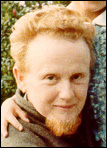
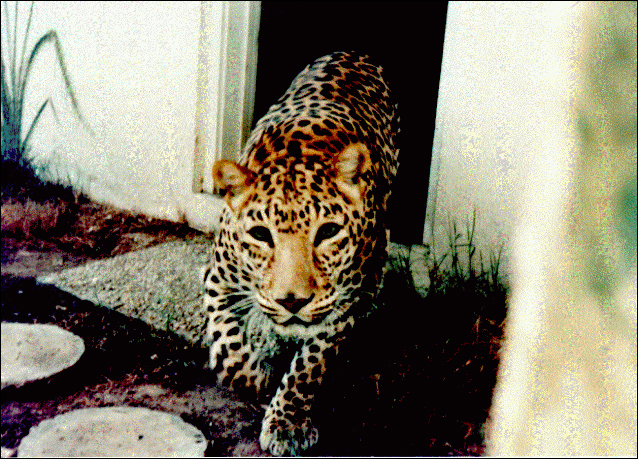
After her father’s death in 1962, Rita inherited the family business which she ran successfully until she sold it to Arrow Electronics at the end of the decade for several million dollars. In 1963, Rita Erickson became a patient of Dr. Harry Benjamin and began the process of masculinizing and living as Reed Erickson. That same year Reed Erickson also married for the first time. Over the next 30 years, Erickson married again twice and became the father to two children.
He lived a very colourful and successful life, eventually amassing a personal fortune estimated at over US$40 million. He lived for many years with his family and his pet leopard, Henry, in an opulent home in Mazatlan Mexico which he dubbed the Love Joy Palace. Later in life, he moved to southern California. Sadly, by the time of his death in 1992 at the age of 74, he had become addicted to illegal drugs and died in Mexico as a fugitive from US drug indictments.
WHY WAS ERICKSON IMPORTANT?
In 1964, Reed Erickson launched the Erickson Educational Foundation (EEF), a philanthropic organization funded entirely by Erickson himself. The Erickson Educational Foundation’s stated goals were “to provide assistance and support in areas where human potential was limited by adverse physical, mental or social conditions, or where the scope of research was too new, controversial or imaginative to receive traditionally oriented support.”
The EEF had three main foci of funding over the twenty years during which it was active. One of its earliest and longest running recipients of financial support was the early homophile organization ONE Inc. of Los Angeles, founded in 1952 and still operating today, which received the benefit of over US$2 million dollars of support from Erickson. Another major area of Erickson’s interest was what have come to be called New Age Movements. The EEF funded what was possibly the first English-language publication on acupuncture. It supported research into homeopathy long before it became well known. Erickson’s money helped to support the work of Robert Masters and Jean Houston and their research into non-drug-induced altered states of consciousness and Stanley Krippner’s dream research. The Erickson Educational Foundation also helped to support John Lilly’s early research into dolphin communications systems and funded the first edition of A Course in Miracles. However, the main centre of Erickson’s attention through the EEF was transsexualism.
WHAT REED ERICKSON AND THE EEF DID FOR TRANSSEXUALISM
When Erickson began the Erickson Educational Foundation, transsexualism was little known to either professionals or the public. The present wide-spread recognition of transsexualism as a human condition can be partially attributed to the activities of the Erickson Educational Foundation.
Under the auspices of the EEF, Erickson made tremendous contributions to the understanding of transsexualism. The EEF helped to support, both through direct financial contributions and through contributions of human and material resources, almost every aspect of work being done in the 1960s and 1970s in the field of transsexualism in the US and, to a lesser degree, in other countries. The EEF funded many early research efforts, including the creation of the Harry Benjamin Foundation, the early work of the Johns Hopkins Clinic and numerous other important research projects. It developed and maintained an extensive referral list of service providers throughout the US and in several other locales.
The EEF sponsored innumerable public addresses on the topic of transsexualism in educational venues directed at medical professional and personnel, clergy, law enforcement officers, and university and college students. The EEF also sponsored educational films, radio and television appearances, and newspaper articles bringing transsexualism to the attention of the public. In addition, the EEF also sponsored numerous publishing endeavours in the field of transsexualism including an informative quarterly newsletter, an invaluable set of educational pamphlets, and two major early reference works on the topic, Money & Green’s (1969) Transsexualism and Sex Reassignment and Money & Ehrhardt’s (1972) Man, Woman, Boy, Girl. Furthermore, the EEF was instrumental in organizing several of the earliest international conferences on transsexualism and in bringing discussions about transsexualism to conferences of broader interest.
During the years 1964 -1970 and 1972 – 1975 alone, the EEF donated approximately US$250,000 to the support of projects about transsexualism. In particular, the Harry Benjamin Foundation received over US$60,000 during 1964 – 1968 and the Johns Hopkins Gender Identity Clinic received approximately US$72,000 during the formative years of 1967 – 1973.
THE EEF AND THE HARRY BENJAMIN INTERNATIONAL
GENDER DYSPHORIA ASSOCIATION [HBIGDA]
In a general sense, the support offered by Reed Erickson through the EEF was foundational to much of the early work done in the field of transsexualism in the US and, to a lesser extent, elsewhere. The educational and support work done by Erickson’s EEF on behalf of transsexual people and the financial and other material support provided to researchers by Erickson through the EEF laid the groundwork for the formation of The Harry Benjamin International Gender Dysphoria Association (HBIGDA). The contribution to the development of the study and understanding transsexualism of Reed Erickson and the EEF is incalculable.
More specifically, Reed Erickson and the EEF contributed directly to the formation of HBIGDA by sponsoring the 1st, 2nd, and 3rd International Symposia on Gender Identity. These three symposia constituted the first three in the biannual series which later became known as The HBIGDA Symposia. In 1999, HBIGDA convened its 16th Symposium, once again meeting in London, thirty years after the 1st International Symposium on Gender Identity.
The 1st International Symposium on Gender Identity: Aims, Functions and Clinical Problems of a Gender Identity Unit, took place at the Piccadilly Hotel in London, July 25-27, 1969 and was co-sponsored by the EEF and the Albany Trust of London. It was chaired by Professor C.J. Dewhurst of Queen Charlottes’s Hospital, London.
The 2nd International Symposium on Gender Identity, sponsored by the EEF, was held at the Marienlyst Hotel in Elsinnore, Denmark, September 12-14, 1971. The first day, Psychological, Hormonal and Surgical Management of Transsexualism, was chaired by Anke Ehrhardt and Donald Laub. The Second day, Sociological and Legal Aspects of Transsexualism, was chaired by P. Fogh-Anderson and Marie Mehl. The third day, Possible Etiological Factors in Transsexualism, was chaired by C.J. Dewhurst and Richard Green.
The 3rd International Symposium on Gender Identity, sponsored by the EEF, was held at the Hotel Libertas in Dubrovnik, Yugoslavia, Sept 8-10, 1973. It continued the process of bringing together researchers from numerous countries to discuss their common interests in transsexualism and gender dysphoria. It was the last of the conferences convened by the EEF.
The 4th conference in this series was sponsored by the Division of Reconstructive and Rehabilitation Surgery, Stanford University Medical Center, Stanford, California. It took place at the Faber Auditorium of the Children’s Hospital at Stanford in Palo Alto, California on February 28 to March 2, 1975. It was the first conference to use the name Harry Benjamin. It was called The Harry Benjamin 4th International Conference on Gender Identity in honour of Harry Benjamin’s 90th birthday in the year 1975. The name of Harry Benjamin had not yet been adopted in any formal sense.

In 1977, the 5th International Gender Dysphoria Symposium was held in Norfolk, Virginia, February 10-13. It was hosted by the Eastern Virginia Medical School and the Eastern Virginia Inter-Hospital Medical Education Committee. An urgent last minute addition appeared at the front of the program announcing the demise of the EEF:
Just prior to the meeting we have learned that the Erickson Educational Foundation, which we all consider a vital force in the area of transsexualism, will cease to exist. This impartial educational agency has been of inestimable value to the field. the conference planning committee will schedule a business meeting in lieu of one of the discussion periods to discuss the expected effect of this event on the field and to brainstorm about the implications of this to the ongoing communication which all of us have enjoyed through the tireless efforts of Zelda Suplee [Director of EEF].
It was at this meeting, called in direct response to the chasm left in the field of transsexualism by the withdrawal of the support of the EEF, that HBIGDA and the Standards of Care were conceived. By the end of the 5th Symposium, the founding committee of HBIGDA had been chosen and Paul Walker was charged with drawing up articles of incorporation for the new organization.
The 6th International Gender Dysphoria Symposium was held in San Diego, California in February, 1979. The formation of the Harry Benjamin International Gender Dysphoria Association was formally approved at that meeting. On September 14, 1979 HBIGDA was officially incorporated as a non-profit corporation in the State of Texas. The incorporators were Paul Walker, Walter Meyer, III, and Alice Webb. The original Directors of HBIGDA were the founding committee of Jack Berger, Richard Green, Donald Laub, Charles Reynolds, Jr., Paul Walker, and Leo Wollman plus Jude Patton who was then the Co-Director of Renaissance, a transsexual service organization. HBIGDA was born.
In 1983, Reed Erickson revived the Erickson Educational Foundation for approximately one year. One of the projects to receive funding and material support was the creation of a newsletter for HBIGDA. The newsletter lasted one year, the duration of EEF’s funding. It was created using facilities in the basement of Erickson’s home in Ojai, California and its physical format duplicated almost exactly that of the EEF’s own newsletters. The front page of Volume 1, Number 1 of the HBIGDA newsletter bore this inscription:
Deep Appreciation
For a long time Harry Benjamin has urged the publication of a newsletter for the Association. It has finally been made possible through the generous grant of the Erickson Educational Foundation, and the officers and membership of the organization are deeply grateful. The Erickson Educational Foundation was the pioneering source of support for research, referral and public and professional information in the field of gender dysphoria.
SOME OF THE PEOPLE FUNDED BY THE EEF FOR RESEARCH
RELATED TO TRANSSEXUALISM
PERSON FUNDED
Harry Benjamin
John Brennan
Vern Bullough
Harold T. Christensen
C.J. Dewhurst
Milton Diamond
Milton T. Edgerton
Anke Ehrhardt
Deborah Feinbloom
Norman Fisk
Roger Gorski
Richard Green
Howard W. Jones
Donald Laub
Elizabeth McCauley
Marie Mehl
Jon K. Meyer
John Money
Ira B. Pauly
Richard Pillard
June Reinisch
Paul Walker
Irvin Yalom
POSITION WHEN FUNDED
Endocrinologist
Psychologist
Historian
Sociologist
Gynecologist
Professor
Surgeon
Psychologist
Social Psychologist
Psychiatrist
Neurobiologist
Psychiatrist
Surgeon
Surgeon
Doctoral candidate
Psychologist
Psychiatrist
Psychologist
Psychiatrist
Psychiatrist
Doctoral candidate
Doctoral candidate
Psychiatrist
AFFILIATION WHEN FUNDED
Private practice
Johns Hopkins Clinic
San Fernando Valley State Clinic
Purdue University
Chelsea Hospital for Women, London
University of Hawaii
Johns Hopkins Clinic
SUNY at Buffalo
Boston
Stanford U Gender Clinic
University of California
UCLA
Johns Hopkins Clinic
Stanford University Gender Clinic
SUNY at Buffalo
Miami
Johns Hopkins Clinic
Johns Hopkins Clinic
University of Nevada
Boston University
Teachers’ College
U. of Rochester
Stanford University Gender Clinic
SOME PUBLICATIONS ON TRANSSEXUALISM PARTIALLY
OR FULLY FUNDED BY THE EEF
- Sex Errors of the Body: Dilemmas, Education and Counseling, Money, 1968
- Transsexualism and Sex Reassignment, Money & Green, 1969
- Man, Woman, Boy, Girl, Money & Ehrhardt, 1972
- Harry Benjamin International Gender Dysphoria Association newsletter (Vol. 1: 1983-1984)
The Erickson Educational Foundation Pamphlet Series:
-
- Letter from a Brother of a Transexual (1969)
- Letter from a Mother (1969)
- An Outline of Medical Management of the Transexual (1971)
- Legal Aspects of Transexualism (1971)
- Information for the Family of the Transexual and Children with Gender Identity Disturbances (1971)
- Religious Aspects of Transexualism (1971)
- Information on Transexualism for Law Enforcement Officers (1973)
- Counseling the Transexual: Five Conversations with Professionals in Transsexual Therapy (1973)
- Guidelines for Transexuals (1974)
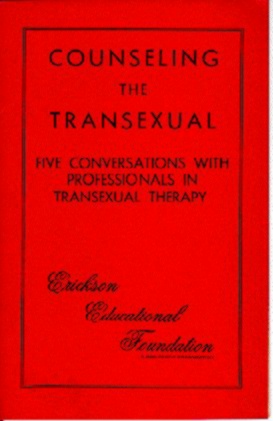
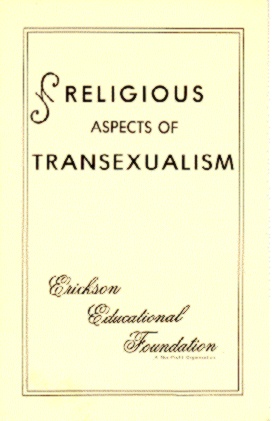

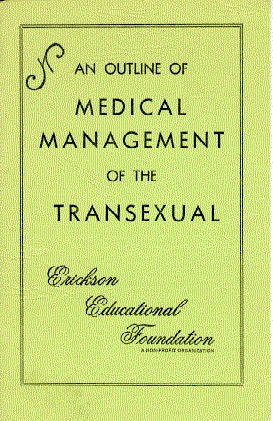
SOME OF THE PROJECTS RELATED TO TRANSSEXUALISM
SUPPORTED BY THE EEF
- Harry Benjamin Foundation, New York, USA, 1964 – 1968
- Johns Hopkins Gender Identity Clinic, Baltimore, USA, 1967 – 1973
- 1st International Symposium On Gender Identity, London, UK, 1969
- Albany Trust, London, UK, 1969 – 1970
- Preliminary Invitational Florida Symposium On Gender Identity, Miami, USA, 1970
- 2nd International Symposium On Gender Identity, Copenhagen, Denmark, 1971
- Invitational workshop for faculty members of University Gender Identity Medical Units, New Orleans, USA, 1971
- Symposium on the transsexual phenomenon at Fairleigh Dickinson University, New Jersey, USA, 1971
- Seattle Counseling Center for Sexual Minorities, USA, 1972 – 1973
- National Transsexual Counseling Unit (NTCU), San Francisco, CA, USA,1972 – 1974
- 3rd International Symposium on Gender Identity, Dubrovnik, Yugoslavia, 1973
- Symposium on Transsexualism, Philadelphia, USA, 1973
- New York Academy of Medicine Symposium on Gender Identity, USA, 1973
- Symposium on Gender Identity, Kings Cross Training Centre, London, UK, 1974
- Janus Information Facility, Galveston & San Francisco, USA, 1977 – 1980
- Stanford University Gender Identity Clinic, USA
- San Francisco Police Community Relations Unit, USA
MORE ABOUT REED ERICKSON
Comments? Additions? Corrections?
“Reed Erickson and The Erickson Educational Foundation” written by Aaron Devor, Ph.D.
Visit Aaron Devor’s Webpage
Webpage created by Josephine MacIntosh. Please report broken links
Last revised December 15, 2020